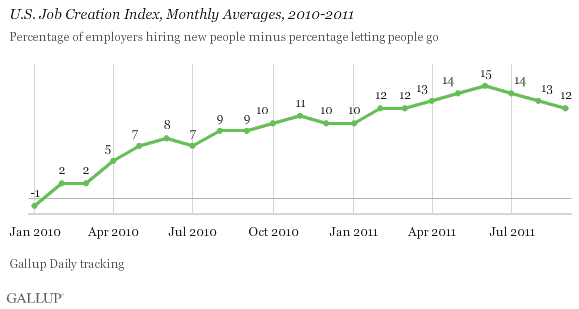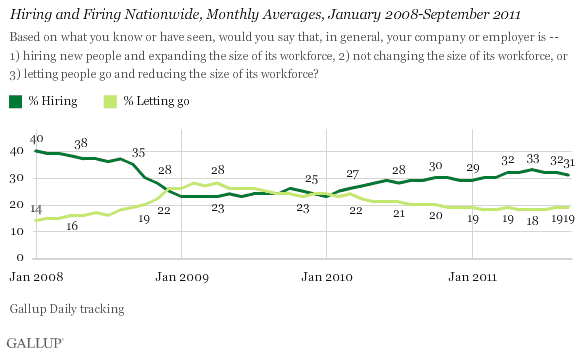WASHINGTON, D.C. -- U.S. job creation continues to steadily abate, reversing the upward trend seen since the start of 2010. The nation's Job Creation Index score slid to +12 in September, marking the third straight month of decline, but remains up slightly from +9 a year ago.

Gallup's September Job Creation Index score of +12 reflects the 31% of employed Americans nationwide who say their employer is hiring new workers and expanding the size of its workforce minus the 19% who say their employer is letting workers go and reducing the size of its workforce.
Hiring has exceeded firing every month since February 2010, reflecting significant improvement compared with late 2008 through the start of 2010, when job contraction exceeded or rivaled job creation. Still, the nation's current Job Creation Index score is again less than half of what it was (+26) when Gallup began tracking job creation daily in January 2008.

Midwest Leads Decline
The Midwest saw the biggest decline from August to September, down five percentage points to +14. It now ties the South for the best job creation conditions in the nation. Conversely, the West improved its overall index score to +12. The East still lags behind the nation with an overall score of +9.

Implications
While Gallup's monthly trend shows a clear downward pattern, reports do vary slightly from week to week. The U.S. Department of Labor last week reported a decline in new jobless claims for the week ending Sept. 24, and Gallup's Job Creation Index also found its comparable week to be the best week of the month. Similarly, the government and the Gallup measure found the comparable week ending Sept. 10-11 to be the worst week of the month, with the most new jobless claims and the lowest weekly Job Creation Index score.
An important distinction is that the government's measure is seasonally adjusted, and the Labor Department has acknowledged challenges with its adjustments this year. Gallup's real-time measure based on employee reports without seasonal adjustment does suggest different seasonal dynamics this year. The U.S. job creation situation appears to be weakening during the transition from summer into fall, whereas during the past two years, it was steady or improving. In 2008, however, the situation was getting worse at this time of year, and much more rapidly so, as the nation experienced recession.
Employers may be holding back on hiring partly because of the growing economic pessimism and recent declines on Wall Street and the ongoing financial challenges facing the eurozone. A sustained reversal of the job creation gains seen earlier in the year would of course be a troubling setback for the U.S. economy's recovery -- and for the millions of Americans still seeking the full-time "good jobs" that only sustained job creation can provide.
Gallup.com reports results from these indexes in daily, weekly, and monthly averages and in Gallup.com stories. Complete trend data are always available to view and export in the following charts:
Daily: Employment, Economic Confidence and Job Creation, Consumer Spending
Weekly: Employment, Economic Confidence, Job Creation, Consumer Spending
Read more about Gallup's economic measures.
View our economic release schedule.
Survey Methods
For Gallup Daily tracking, Gallup interviews approximately 1,000 national adults, aged 18 and older, each day. The Gallup Job Creation Index results are based on a random sample of approximately 500 current full- and part-time employees each day.
National results for September are based on Gallup Daily tracking interviews with 16,604 employees conducted Sept. 1-30, 2011. For this sample, one can say with 95% confidence that the maximum margin of sampling error is ±1 percentage point. Regional results for September are based on interviews totaling more than 3,000 in each region. For each total regional sample, the maximum margin of sampling error is ±2 percentage points.
Interviews are conducted with respondents on landline telephones and cellular phones, with interviews conducted in Spanish for respondents who are primarily Spanish-speaking. Each sample includes a minimum quota of 400 cell phone respondents and 600 landline respondents per 1,000 national adults, with additional minimum quotas among landline respondents by region. Landline telephone numbers are chosen at random among listed telephone numbers. Cell phone numbers are selected using random-digit-dial methods. Landline respondents are chosen at random within each household on the basis of which member had the most recent birthday.
Samples are weighted by gender, age, race, Hispanic ethnicity, education, region, adults in the household, and phone status (cell phone only/landline only/both, cell phone mostly, and having an unlisted landline number). Demographic weighting targets are based on the March 2010 Current Population Survey figures for the aged 18 and older non-institutionalized population living in U.S. telephone households. All reported margins of sampling error include the computed design effects for weighting and sample design.
In addition to sampling error, question wording and practical difficulties in conducting surveys can introduce error or bias into the findings of public opinion polls.
For more details on Gallup's polling methodology, visit www.gallup.com.
